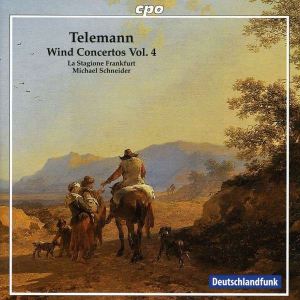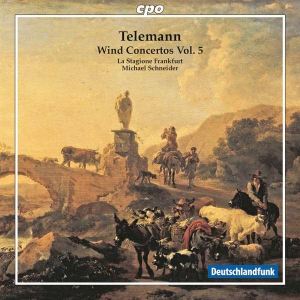 |
 |
| 

alternatively
CD: MDT
AmazonUK
AmazonUS
Sound
Samples & Downloads |
Georg Philipp TELEMANN
(1681 - 1767)
Wind Concertos Vol. 4
Concerto for 2 recorders, strings and bc in a minor (TWV 52,a2)
[09:14]
Concerto for transverse flute, strings and bc in D (TWV 51,D2) [12:39]
Concerto for oboe d'amore, strings and bc in A (TWV 51,A2) [14:58]
Concerto for 2 transverse flutes, bassoon, strings and bc in b minor
(TWV 53,h1)* [11:05]
Concerto for oboe, strings and bc in e minor (TWV 51,e1) [12:28]
 Michael Schneider (recorder, transverse flute*, Martin Hublow (recorder),
Karl Kaiser (transverse flute), Martin Stadler (oboe, oboe d'amore),
Marita Schaar (bassoon)
Michael Schneider (recorder, transverse flute*, Martin Hublow (recorder),
Karl Kaiser (transverse flute), Martin Stadler (oboe, oboe d'amore),
Marita Schaar (bassoon)
La Stagione Frankfurt/Michael Schneider
rec. 10 - 12 September 2007, Chamber Music Hall of Deutschlandfunk,
Cologne, Germany. DDD
 CPO 777 400-2 [60:47] CPO 777 400-2 [60:47]  |


alternatively
CD: MDT
AmazonUK
AmazonUS
Sound
Samples & Downloads |
Georg Philipp TELEMANN
(1681 - 1767)
Wind Concertos Vol. 5
Concerto for transverse flute, strings and bc in D (TWV 51,D1) [15:39]
Concerto for 2 oboi d'amore, 2 violins and bc in A (TWV 52,A1) [08:59]
Concerto for recorder, strings and bc in F (TWV 51,F1) [13:11]
Concerto for 2 horns, strings, 2 oboes and bc in E flat (TWV 52,Es1)
[05:53]
Concerto for oboe, strings and bc in d minor (TWV 51,d2) [13:52]
Concerto for 2 transverse flutes, bassoon, strings and bc in e minor
(TWV 52,e2)* [11:47]
 Michael Schneider (recorder, transverse flute*), Karl Kaiser (transverse
flute), Luise Baumgartl (oboe, oboe d'amore), Martin Stadler (oboe
d'amore), Ulrich Hübner, Jörg Schulteß (horn) Michael Schneider (recorder, transverse flute*), Karl Kaiser (transverse
flute), Luise Baumgartl (oboe, oboe d'amore), Martin Stadler (oboe
d'amore), Ulrich Hübner, Jörg Schulteß (horn)
La Stagione Frankfurt/Michael Schneider
rec. 3 - 7 February 2009, Chamber Music Hall of Deutschlandfunk, Cologne,
Germany. DDD
 CPO 777 401-2 [67:48] CPO 777 401-2 [67:48]  |
| |
The concertos are one of the lesser-known parts of the oeuvre
of Georg Philipp Telemann. He himself didn't rate them very
highly, as he was more interested in the form of the orchestral
overture. This reflected his strong preference for the French
style. The concerto was a product of the Italian style, and
this had some features he didn't particularly like. He wrote
that in the concertos of some of his contemporaries he encountered
"many difficulties and awkward leaps but little harmony and
even poorer melody. The first qualities I hated because they
were uncomfortable for my hand and bow, and owing to the lack
of the latter qualities, to which my ears were accustomed through
French music, I could neither love them nor desire to imitate
them".
His output in this genre is considerable, though. The catalogue
lists more than fifty solo concertos, almost thirty double concertos,
seventeen triple concertos and nine concertos with four solo
instruments. In the majority of his concertos he avoids the
Vivaldian form in three movements, but rather follows the model
of the sonata da chiesa, with its sequence of four movements,
slow-fast-slow-fast. That is also the case in all but one of
the concertos on these two discs, which are part of a series
with all Telemann's concertos for wind instruments. The only
exception is the Concerto for two horns in E flat (Vol.
5). This has everything to do with his distaste for virtuosity
as an end in itself. By opening a concerto with a slow movement,
it was rather the expression or the lyrical features of a solo
instrument which were placed at the centre of attention. Despite
Telemann's statement that his concertos "mostly smell of France",
they are examples of the goûts réunis, the
mixture of French and Italian styles which were the ideal of
most German composers of his time.
Only three concertos were published during Telemann’s
life and they form part of his collection Tafelmusik.
The other concertos have survived in manuscript. It is almost
impossible to date them with any amount of certainty, as most
copies don't indicate the year of composition. It is assumed,
though, that the largest part of Telemann's output in this genre
dates from before 1735. After that he seems only to have composed
solo concertos for specific occasions. Telemann was originally
educated in playing the harpsichord, the violin and the recorder,
but during his development as a composer aimed to achieve a
grasp of the features of all instruments in vogue in his time.
In his autobiography of 1740 he wrote that he wanted "to make
myself familiar not only with the harpsichord, violin, and recorder
but also with the oboe, transverse flute, chalumeau, gamba,
etc., up to the double bass and the trombone pitched a fifth
below". This resulted in his compositions for the various instruments
being remarkably idiomatic.
Volumes 4 and 5 in this CPO series are mainly devoted to more
or less 'conventional' instruments: recorder, transverse flute
and oboe. Less common are concertos for oboe d'amore and those
for two or three instruments, like two oboi d'amore, two horns
or two transverse flutes and bassoon. Most concertos have the
usual accompaniment of strings and basso continuo. There are
some exceptions, though. In the Concerto in E flat (Vol.
5) the strings are joined by two oboes, whereas in the Concerto
for two oboi d'amore in A (Vol. 5) the accompaniment is
reduced to two violins and bc. The latter is comparable to the
concerto da camera as we know it from the oeuvre of Vivaldi.
The Italian style is represented not only in formal aspects
of these concertos, in particular in the ritornellos, but also
in their content. A striking example is the largo from the Concerto
for oboe d'amore in A (Vol. 4), which has an ABA structure,
and whose B section is a kind of accompagnato as in an
opera, with the solo instrument as the singer. The most Italian
concerto on these discs is the Concerto for oboe in d minor
(Vol. 5). It opens with a largo which contains frequent general
pauses, and is one of the most expressive movements on these
discs. An interesting combination of Italian and French influences
offers the Concerto for two horns in E flat (Vol. 5).
It is in three movements, with particularly virtuosic parts
for the horns in the first movement. The second is a largo,
in which only the strings are playing. The ornamented episodes
for two violins are Italian while the role of the oboes is French
which play colla parte with the strings. The latter is
a feature of French music by, for instance, Lully. The last
movement is a vivace, which has the form of a rondeau; something
particularly popular in France.
French influence also comes to the fore in the Concerto for
two recorders in a minor (Vol. 4) and even more in the Concerto
for two flutes and bassoon in b minor (Vol. 4), which begins
with a grave, followed by a vivace. Together they
could be the first movement of an orchestral overture in French
style. This concerto belongs to a group of six which were probably
composed during Telemann's years in Frankfurt. They have the
same superscription in French, "Concert par moi Telemann", and
the solo instruments - two transverse flutes and bassoon - are
also referred to with their French names. The Concerto in
e minor (Vol. 5) belongs to this group as well. The last
movement of this concerto is a minuet, again in the form of
a rondeau.
The second movement begins with a polonaise, and that refers
to a third influence on Telemann's oeuvre: folk music, in particular
from Poland. That is also traceable in the Concerto for transverse
flute in D (Vol. 4), which opens with a moderato, again
in the form of a polonaise. This concerto has a pastoral character,
and so has the Concerto for oboe d'amore in A (Vol. 4),
which begins with a siciliano. Interesting in this respect is
the Concerto for 2 oboi d'amore in A (Vol. 5) the third
movement of which is again a siciliana with strong reminiscences
of an Italian Christmas concerto.
Lastly some interesting aspects need to be highlighted. Telemann
is often associated with entertaining music of a happy nature.
The largo from the Concerto for oboe in d minor (Vol.
5) which I have already mentioned before shows there is also
a darker side to his oeuvre. The largo from the Concerto
for flute in D (Vol. 5) also has a highly expressive character.
Telemann may have disliked virtuosity as an end in itself but
his concertos are certainly not devoid of virtuosic solo parts.
I have already mentioned those for the two horns in the Concerto
in E flat. The closing allegro from the Concerto for
flute in D and the allegro from the Concerto for recorder
in F (Vol. 5) are evidence of that as well. Telemann's use
of the oboe d'amore as a solo instrument in several concertos
is particularly notable. This instrument was only developed
in the second decade of the 18th century in southern Germany.
According to Wolfgang Hirschmann, who wrote the excellent liner-notes
for these two discs, it is quite possible that Telemann's concertos
belong among the first - or are even the first - concertos
ever written for this instrument.
The previous volumes of this series with Telemann's concertos
for wind instruments have been received with enthusiasm (see
below), and that is understandable. They prove the brilliance
and originality of Telemann as a composer of concertos. He was
praised for this by his contemporaries. Johann Adolf Scheibe,
for instance, admired Telemann for his ability to write in various
national styles and yet always remaining himself. He also characterised
his compositions as "körnicht", meaning something like
'energetic', 'to the point'. These two discs completely validate
his judgement. That is also due to the fine playing of La Stagione
Frankfurt. The ensemble is immaculate and energetic, and the
execution of the solo parts leaves nothing to be desired. Karl
Kaiser (transverse flute), Michael Schneider (recorder and transverse
flute), Martin Stadler and Luise Baumgartl (oboe and oboe d'amore),
Marita Schaar (bassoon) and Ulrich Hübner and Jörg
Schulteß (horns) deal with the various features of their
solo parts convincingly. The variety in character between the
concertos comes well to the fore here.
Telemann enjoys growing popularity among music-lovers. Those
who have discovered his genius should not hesitate to add these
discs to their collection. Others could well become Telemann
aficionados after listening to them. There is every reason to
look forward to the next volumes in this series.
Johan van Veen
http://www.musica-dei-donum.org
https://twitter.com/johanvanveen
Reviews of other releases in this series
Volume
1 Volume
2
|
|

